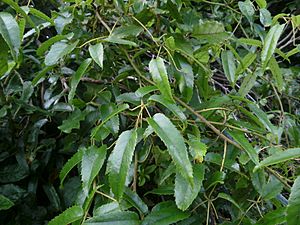Bush lawyer (plant) facts for kids
Quick facts for kids Bush lawyer plant |
|
|---|---|
 |
|
| Rubus cissoides | |
| Scientific classification |
|
| Kingdom: | Plantae |
| Clade: | Tracheophytes |
| Clade: | Angiosperms |
| Clade: | Eudicots |
| Clade: | Rosids |
| Order: | Rosales |
| Family: | Rosaceae |
| Genus: | Rubus |
| Subgenus: | Rubus subg. Micranthobatus |
| Species | |
|
|
Bush lawyer is a common name for a group of climbing plants found in New Zealand. These plants are a type of blackberry and belong to a special group called Micranthobatus within the Rubus family. Many of them are strong vines that grow in forests. The Māori language name for this plant is tātarāmoa.
Tātaramoa, or bush lawyer, has hooked thorns. These thorns can easily catch onto clothing. They can also scratch or prick your skin if you are not careful.
Contents
What is Bush Lawyer?
Bush lawyer plants are known for their long, climbing stems. They use their thorns to help them climb up other plants and trees. This allows them to reach sunlight in the dense forest canopy. These plants are found all over New Zealand, growing up to 1000 meters high.
Why is it Called "Bush Lawyer"?
The interesting name "Bush lawyer" comes from how the plant behaves. People say it's like a lawyer because once it grabs onto you, it doesn't let go easily! Its backward-pointing thorns are very good at holding on. If you accidentally walk into a bush lawyer plant, its thorns can snag your clothes or skin. It can be tricky to free yourself without getting tangled.
What Does Bush Lawyer Look Like?
Bush lawyer plants have leaves that often look like a hand. They usually have three to five 'fingers' or leaflets, which have small teeth along their edges. The plant produces white flowers. After the flowers, it grows small fruits that look like tiny blackberries. These berries are usually yellowish-red when they are ripe.
Uses of Bush Lawyer
In the past, early European settlers in New Zealand used the berries from bush lawyer plants. They would collect the fruits to make delicious jams and jellies. This shows that even though the plant has sharp thorns, it also provides a useful food source.

